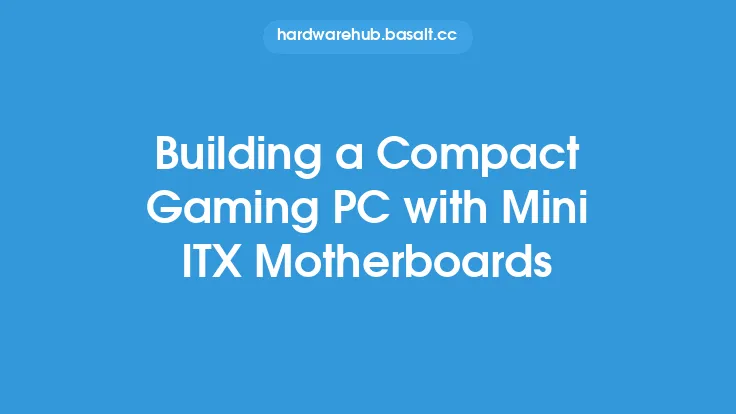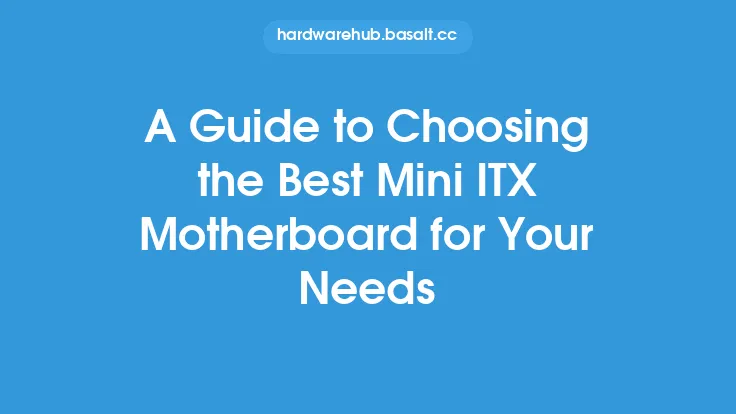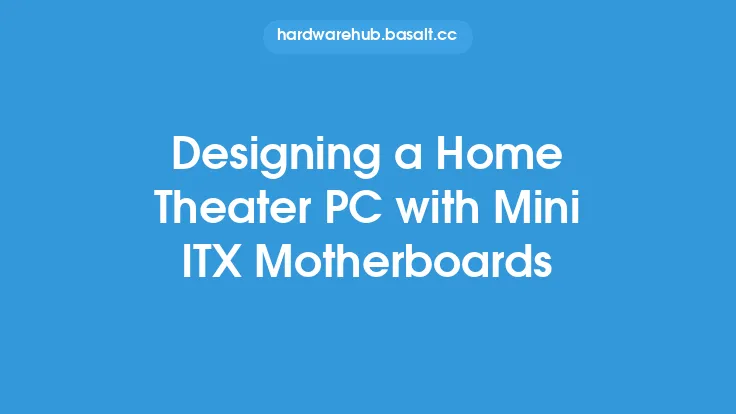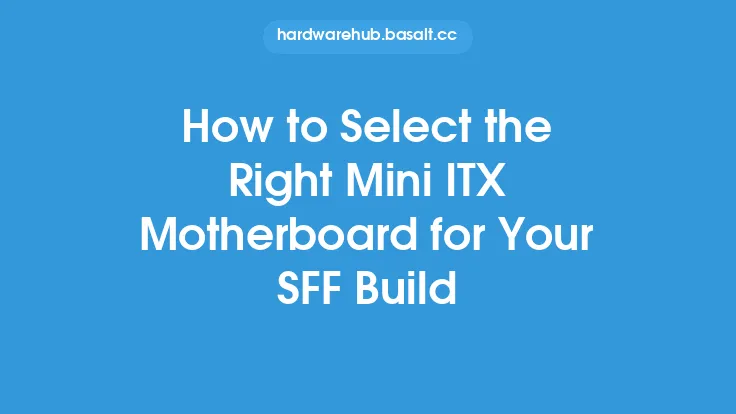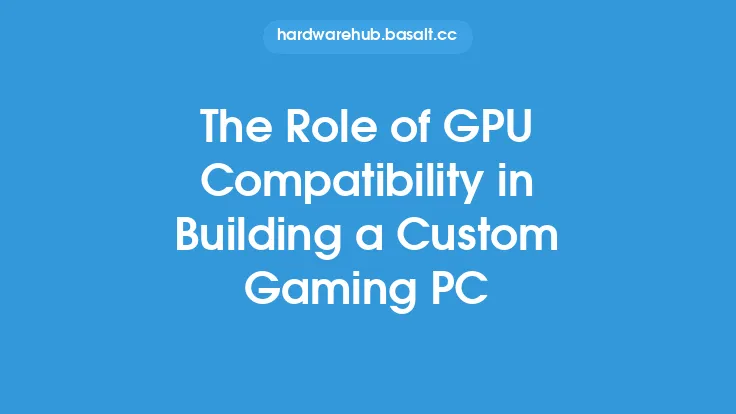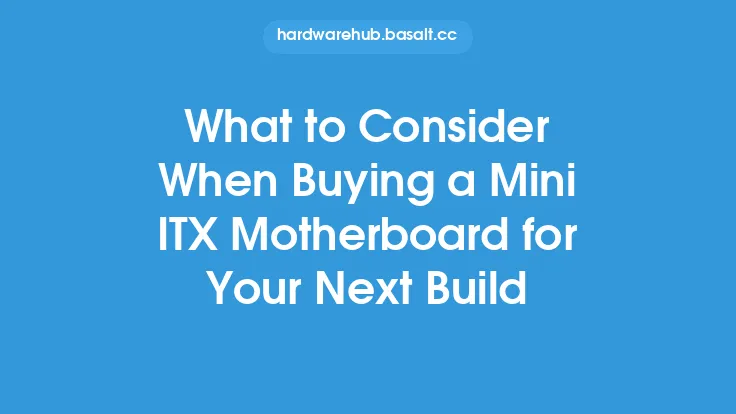Building a mini ITX gaming PC can be a fun and rewarding experience, offering a unique combination of power, portability, and style. With the right components and a bit of planning, you can create a system that is capable of handling even the most demanding games and applications. In this guide, we'll walk you through the process of building a mini ITX gaming PC, covering everything from choosing the right components to assembling and configuring the system.
Introduction to Mini ITX Motherboards
Mini ITX motherboards are a type of small form factor (SFF) motherboard that measures just 6.7 inches square. Despite their compact size, mini ITX motherboards are capable of supporting a wide range of components, including powerful CPUs, high-end graphics cards, and ample storage. They are ideal for building small, portable gaming PCs that can be easily transported to LAN parties or used in small spaces.
Choosing the Right Components
When building a mini ITX gaming PC, it's essential to choose components that are compatible with the mini ITX form factor. Here are some key components to consider:
- CPU: Look for a CPU that is compatible with the mini ITX motherboard you've chosen. Some popular options include Intel Core i5 and i7 processors, as well as AMD Ryzen 5 and 7 processors.
- Graphics Card: A high-end graphics card is essential for gaming. Look for a card that is compatible with the mini ITX form factor and has enough power to handle demanding games. Some popular options include the NVIDIA GeForce RTX 3080 and the AMD Radeon RX 6800 XT.
- RAM: Choose RAM that is compatible with the mini ITX motherboard and has a sufficient amount of memory to handle demanding applications. 16 GB or 32 GB of RAM is a good starting point.
- Storage: Choose a storage drive that is fast and has enough capacity to store your games and applications. A solid-state drive (SSD) is a good option, as it offers fast loading times and responsive performance.
- Power Supply: Choose a power supply that is compatible with the mini ITX form factor and has enough power to handle the components you've chosen. A 650 W or 750 W power supply is a good starting point.
Assembling the System
Assembling a mini ITX gaming PC requires careful planning and attention to detail. Here are the general steps to follow:
- Unpack the components and prepare the workspace.
- Install the CPU and CPU cooler on the motherboard.
- Install the RAM on the motherboard.
- Install the storage drive on the motherboard.
- Install the power supply on the case.
- Install the graphics card on the motherboard.
- Connect the front panel headers and fans to the motherboard.
- Connect the power cables to the components.
- Boot up the system and install the operating system.
Configuring the System
Once the system is assembled, it's time to configure it for optimal performance. Here are some key settings to configure:
- BIOS settings: Configure the BIOS settings to optimize performance and stability. This may include settings such as CPU multiplier, RAM timings, and fan speeds.
- Operating system: Install the operating system and configure it for optimal performance. This may include settings such as power management, display settings, and sound settings.
- Graphics card settings: Configure the graphics card settings to optimize performance and image quality. This may include settings such as resolution, refresh rate, and graphics quality.
- Cooling settings: Configure the cooling settings to optimize temperature and noise levels. This may include settings such as fan speeds, fan curves, and liquid cooling settings.
Overclocking and Tweaking
Overclocking and tweaking can help to optimize the performance of the system. Here are some key areas to focus on:
- CPU overclocking: Overclocking the CPU can help to improve performance in games and applications. However, it requires careful planning and attention to detail to avoid overheating and instability.
- Graphics card overclocking: Overclocking the graphics card can help to improve performance in games and applications. However, it requires careful planning and attention to detail to avoid overheating and instability.
- RAM overclocking: Overclocking the RAM can help to improve performance in games and applications. However, it requires careful planning and attention to detail to avoid overheating and instability.
- Cooling tweaks: Tweaking the cooling settings can help to optimize temperature and noise levels. This may include settings such as fan speeds, fan curves, and liquid cooling settings.
Troubleshooting and Maintenance
Troubleshooting and maintenance are essential for keeping the system running smoothly. Here are some key areas to focus on:
- Troubleshooting: Identify and fix common issues such as overheating, instability, and connectivity problems.
- Maintenance: Perform regular maintenance tasks such as cleaning the system, updating the operating system, and checking for firmware updates.
- Upgrades: Plan and execute upgrades to the system, such as adding more RAM or replacing the graphics card.
Conclusion
Building a mini ITX gaming PC can be a fun and rewarding experience, offering a unique combination of power, portability, and style. By choosing the right components, assembling the system with care, and configuring it for optimal performance, you can create a system that is capable of handling even the most demanding games and applications. Whether you're a seasoned builder or a beginner, this guide has provided you with the knowledge and skills needed to build a mini ITX gaming PC that meets your needs and exceeds your expectations.
